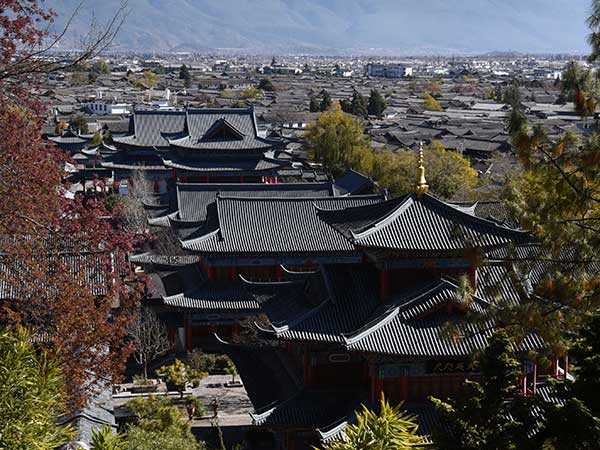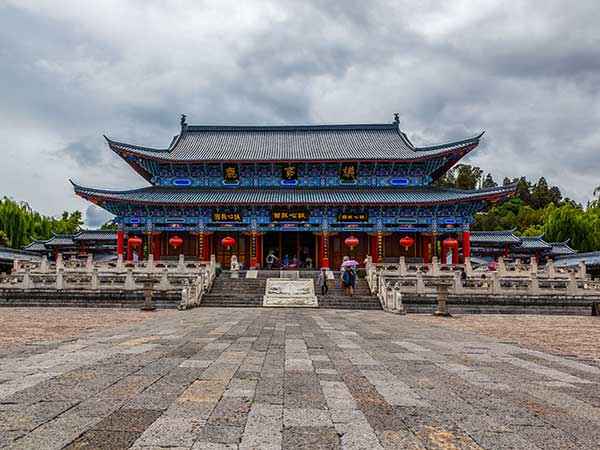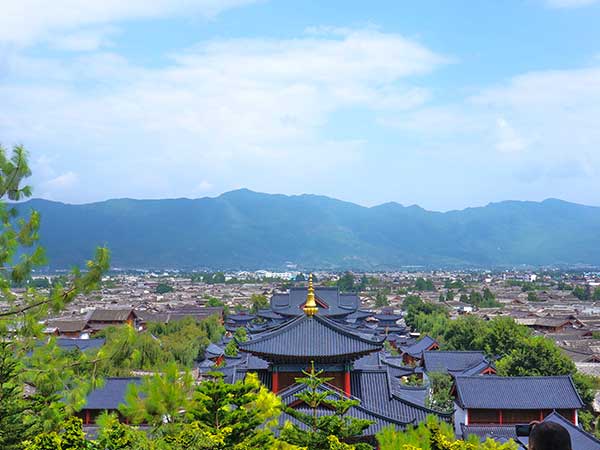Mufu Palace or Mu Family Mansion, is short for Palazzo della Famiglia Mu. Located on the foot of Lion Mountain, Mufu Palace is the grand garden of Lijiang Ancient Town.
Lijiang Ancient Town is the famous historical site in China, and Mufu Palace is the most recommendation attraction in Lijiang. The top ruler of Naxi minority Mu Family had been in Lijiang since Yuan Dynasty to Qing Dynasty, totally 470 years with 22 generation rulers. During the late Ming Dynasty, Mu Family was in the peak time. And the elaborate decoration of this palace was surprised by Xu Xiake, the famous ancient geologist. He spoke highly of this palace in the sentence “As gorgeous as the imperial palace”.
Mufu Palace witnesses the history of Lijiang. Located on the southwestern corner of Lijiang Ancient City, Mufu Palace is surrounded by Jade Dragon Snow Mountain in the left, Tiger Mountain in the right, and Lion Mountain at the back.
Covering about 46 mu (Chinese area unit, 1 mu = 666 sq km), the central axis is 369 meters length, Mufu Palace faces to the east direction. It is the highlight of Chinese architecture. The present Mufu Palace is a representative of ancient central China architectural style in Ming Dynasty. While it also keeps the characters of Tang and Song Dynasties. And inside it, the details show the minority features of Bai and Naxi groups. Besides architecture value, it also can be an outstanding plants museum with ancient trees and extraordinary plants. The garden in a style mixed with imperial one and Suzhou’s style.
History of Mu Family
Since the ancient time, Lijiang was the dwelling place of Naxi minority. There was no Han minority name of Naxi minority. When Zhu Yuanzhang (Taizu Emperor of Ming Dynasty) built Ming Dynasty, the minority hereditary headmen of Naxi in Lijiang called Aji Ade immediately shown the honesty of Zhu’s ruling. Zhu was extremely delight so he decided to reward a Han minority family name to Aji Ade and his group. The rewarding family name was “Mu”. From that on, all the Naxi minority hereditary headmen need to used “Mu” as their family names.
During the Mu’s ruling time, aimed to maintain the nobility of their family, they promoted a family name system “Officials with Mu family name, and citizens with He family name”. Mu minority hereditary headmen was passed till the Qing Dynasty.
With Yuan, Ming and Qing three dynasties, Mu’s Palace once covered more than 100 mu, regarded as the heart of Dayan Ancient Town. Surrounded by residents’ houses, Mu family was a respectable family among locals’ minds. Mu’s family followed the discipline “Be knowledge, read literature, and keep righteousness”.
The minority hereditary headmen – Ajia Ade
Series about Mu Mansion – Legend of Mu Mansion (Mu Fu Feng Yun)
Director: Yu Rongguang
Cast:
Choo Ja-Hyun
Yu Rongguang
Ray Lui
Pan Hong
Yu Na
Song Yuncheng
Doris Tang
Country: China
Language: Mandarin
Episodes: 30 (45 minutes per episode)
Genre: Drama
Legend of Mu Mansion (2012)
Interior Architecture
Across the bridge over gurgling spring, you will see a wooden arch was standing between wooden residents tiled roof. Wooden arch was written “Tian Yu Liu Fang” four words, which is the homophone for “reading” in Naxi language, embodies the spirit and wisdom of the Naxi people promoting knowledge and attaching great importance to the education. Turn around wooden memorial arch, on the right hand side is an exquisite carved stone memorial arch, written the word “loyalty”.
Enter into scarlet Mu Mansion gate, a golden resplendent and magnificent palace is standing on a piece of open ground, on the central axis are arranged successively in the chamber, Wanjuan Tower, Dharmapala Temple, Guangbi Building, Yuyin Buiding, Taoist temples and other buildings. On both sides of axis were built the side hall, attic, arcade, courtyard, stagecoach, corridor and a total of more than 160 houses, and they are reliving the magnificence of Tusi of Lijiang.
Chamber: Dignified and spacious, full of power and grandeur, this is the place to deal with government affairs for Tusi.
Wanjuan
Tower
: Collecting the very essence of cultural heritage of two thousands years, thousands rolls of Dongba scriptures, hundreds volumes of Tripitaka, Tusi poetry, calligraphy and painting from numerous celebrities, all of these are academic treasures.
Dharmapala
Temple
(also called rear chamber): It is the place for Tusi family to deal with their home affairs.
Guangdian
Building: A gatehouse of back yard garden, in the history it was praised as “the best of west of Yunnan Province”.
Yuyin Buidling is the place for imperial edict and the place for feasting and dancing.

Travel Tips of Mufu Palace
From May to October of Lijiang is the rainy season, in which the July and August is the most concentrated during the rainy season, the weather in rainy season is changeable. It could turn clear sky into overcast and then downpour fall in the next moment. During this time if you want to travel here, be sure to take with good rain gear in case of an emergency; from November to April of the following year is the dry season, when the sky is clear, the sunshine is sufficient, and the ultraviolet radiation is strong. In such a case, people need to pay attention to sun block.
【Recommended Visiting Hours】 3 to 4 hours
【Best Time to Travel Mu Mansion】 it is suitable to travel all year around. There are glory blossoms in spring. During hot summer to enjoy the tree shade is also very comfortable. Autumn has pleasant climate, which is suitable to visit. And the winter sunshine is sufficient. All season is a good choice to travel Mu Mansion.
【How to Get to Mu Mansion】 after arriving Lijiang Old Town, people can walk along the river of west side of Sifang Street to Mu Mansion, 10 minutes can reach.


